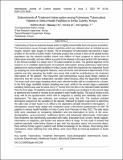| dc.contributor.author | Mwai, Martha | |
| dc.contributor.author | Matiang’i, M. | |
| dc.contributor.author | Keraka, M. | |
| dc.contributor.author | Njuhigu, F. | |
| dc.date.accessioned | 2022-08-19T10:29:00Z | |
| dc.date.available | 2022-08-19T10:29:00Z | |
| dc.date.issued | 2022-08 | |
| dc.identifier.citation | Mwai, M., Matiangi, M., Keraka, M., & Njuhigu, E. (2022). Determinants of Treatment Interruption among Pulmonary Tuberculosis Patients in Select Health Facilities in Embu County, Kenya. International Journal of Current Aspects, 6(2), 41-56. https://doi.org/10.35942/ijcab.v6i2.269 | en_US |
| dc.identifier.other | DOI: https://doi.org/10.35942/ijcab.v6i2.269 | |
| dc.identifier.uri | https://repository.amref.ac.ke/handle/123456789/774 | |
| dc.description | This is an open-access article published and distributed under the terms and conditions of
the Creative Commons Attribution 4.0 International License of United States
unless otherwise stated. Access, citation and distribution of this article is allowed with full
recognition of the authors and the source. Copyright, content ownership and liability for
content herein remain with the authors | en_US |
| dc.description.abstract | Tuberculosis (TB) is an airborne disease which is highly transmissible from one person to another. The transmission occurs through airborne particles which are released when an infected person coughs, sneezes, spits, laughs or shouts. The re-emergence of tuberculosis has become a major problem in the world of public health. Estimates project that at least a third of the global human population has the tubercle bacillus where 9 million of these progress to active form of tuberculosis annually, and 2 million succumb to the disease in the same period. HIV prevalence in the African resulted in a sharp rise in TB cases incidence in 2003. The general objective of the research is to establish determinants of treatment interruption among pulmonary tuberculosis patients from various health facilities in Embu County, which the researcher the researcher found by studying the socio-demographic features, socio-economic and behavioral determinants of the patients and also assessing the health care issues that could be contributing to the treatment interruption of TB patients. The researcher used retrospective causal study design method to determine how the various independent variables (determinants) affect the dependent variable. The study used a two-stage sampling where each selected facility will be considered as a cluster. In the first stage, stratified random sampling was used, while in the second stage a systematic sampling method was used to select every nth record from the files in the selected health facilities from the first stage. Probability proportionate to size sampling was employed in the second stage to determine the number of records to be sampled in each health facility. The tool of choice in this study will be the questionnaire which will be subjected to validity and reliability tests before deployment. The data was collected, and analyzed using Epi info. The analysis included descriptive analysis for the variables in the dataset, followed by logistic regression to determine the odds ratio of each factor in its effect to the dependent variable (treatment interruption). | en_US |
| dc.language.iso | en | en_US |
| dc.publisher | International Journal of Current Aspects | en_US |
| dc.subject | Tuberculosis | en_US |
| dc.subject | Treatment Interrupters | en_US |
| dc.subject | Socio-demographic determinants | en_US |
| dc.subject | Socio-economic determinants | en_US |
| dc.subject | Healthcare factors | en_US |
| dc.subject | Behavioral determinants | en_US |
| dc.title | Determinants of Treatment Interruption among Pulmonary Tuberculosis Patients in Select Health Facilities in Embu County, Kenya | en_US |

